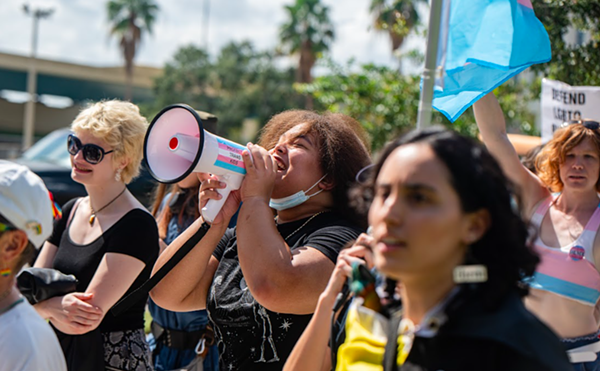Ever since last fall, when the Orlando Magic began stepping up their campaign for a new basketball arena, one question has been on the minds of Orlando's taxpayers and beleaguered hoops fans: If the Magic want a new building so damn much, why can't they just build one themselves?
It's a reasonable enough question. "The Magic," after all, is owner Rich DeVos, who in 1991 plunked down $85 million in Amway cash for the right to cheer on Scott Skiles and Co. from the owner's box. DeVos didn't get the name Rich for nothing: even in these days of dime-a-dozen millionaires, his estimated $1.6 billion net worth is hefty enough to land him in 175th place on Forbes' richest Americans list. This is a man whose company handed over $2.4 million to the Republican National Committee in 1994, the largest single soft-money donation in U.S. political history; a man who, one imagines, could probably pay off the annual financing costs on a quarter-billion-dollar arena with the interest on his savings account.
Add in that the TD Waterhouse Centre, as the erstwhile O-rena was renamed last year, is just 12 years old and still only half paid off by the city, and one can't help wondering: If the home of the Magic, Miracle and Solar Bears has really become a drain on the DeVos family's coffers, couldn't they find the money to replace it themselves?
And the answer is: They could, but that's not the point. Lost amid all the media debates over finance plans and tourist taxes, ticket surcharges and Magic's threatened move to Kentucky, is the simple fact that the push for new arenas that has spread nationwide over the past decade is less about the buildings themselves than about the public subsidies that accompany them -- and the private profit those subsidies help create.
Or as Magic VP Cari Coats explains it: "We don't want a new building just to have a new building. We would just stay where we are. If we're using the revenue to build the building, then we're not getting the revenue, and we're right back where we started, and why do we have a new building?"
Washington State University professor Rodney Fort, co-author of two respected treatises on sports business practices, says ownership nirvana is when: "They're a billionaire. They have an extremely valuable asset like a pro sports team. And then the state, county or city decides to let them stay rent free -- and keep all the revenues that are generated by any activities in the arena."
As for when an arena becomes "obsolete," Fort deadpans, "I don't see anything wrong, from an owner's perspective, with the idea of a new stadium every year."
That is, so long as he's not the one paying for it.
;;
Once upon a time, if you wanted a sports arena, you took out a bank loan and built one. Once the structure was up, at a cost of a couple million dollars or so, you would stock it with hockey games, title fights, and anything else that might help pay off the bank and turn a decent profit. The NBA itself, in fact, got its start as the brainchild of one such era of speculative sports ventures, providing arena owners with a way to fill in the gaps between hockey games in the dead of winter.
What changed the economics of pro sports forever was the discovery that, by offering to jump cities to the highest bidder, team owners could get public officials to front the capital costs of a new building. The first outbreak came in baseball, where the city of Milwaukee began building County Stadium on spec in 1950, in hopes of luring a major-league team. (The Braves arrived from Boston three years later.) Other cities followed suit, and soon enough the Dodgers and Giants had left New York for subsidized stadiums in California, and cities nationwide were rushing to head off their teams' exodus by providing new homes at taxpayer expense.
The stadium-building craze took a while to spread to basketball and hockey, but it took hold with a vengeance in the 1970s. Between 1972 and 1975, Atlanta, Long Island, Indianapolis, Cleveland, Edmonton, Kansas City, Denver and Houston all threw up new arenas in quick succession, pouring $171 million in public money into the sports industry in the span of just four years.
Arenas of that era were still relatively inexpensive in modern terms, with individual buildings seldom breaking the $20 million mark. But once teams realized they were no longer on the hook for all of the construction costs, arena price tags started to go through the roof, as more and more amenities were added onto what had been relatively no-frills buildings where fans were expected to file in, cheer their sports heroes, then file back out. By the time the Orlando Arena opened in 1989, with its 26 skyboxes and built-in TV studio, the $110 million construction cost was twice as expensive as an arena ever built previously; today, the price tag on a new Magic arena is expected to be at least $250 million, a more than 50 percent increase even after figuring in inflation.
Unlike a baseball field that is in use just 81 days each season, or a football stadium with its mere 10-game season, arenas have long been admired by sports-business experts for their flexibility and reusability. As University of Chicago sports economist Allen Sanderson explains, "In theory, something like an indoor arena that hosts a basketball team and a hockey team and can get the occasional circus and Dixie Chicks concert -- can come closer to paying their own way, because potentially you can [book] 150 nights out of the year."
; ;But at some point, rising construction costs simply outstrip arenas' ability to generate revenues, no matter how many Dixie Chicks concerts its managers cram in. The O-rena itself, for example, while turning a small profit on the events it hosts, loses more than $10 million a year once construction debts are figured in. "They tend to still be losers, just not quite as much" as baseball and football stadiums, says Sanderson.
John Christison, who as Orlando Centroplex director in the late 1980s helped direct the design and construction of the Orlando Arena, is even more blunt in his assessment of the profitability of modern arenas. "You rarely see buildings being built without substantial public infusion of cash," says Christison, now general manager of Seattle's convention center. "And the reason for that is pure economics. In some cases, these revenue centers just simply don't generate enough revenue to cover debt service and operating cost."
This, fundamentally, is why teams by and large don't build arenas with their own money: you don't get to be a wealthy sports owner by plunking down $20 million a year in mortgage payments for the privilege of earning an extra $10 million a year in revenues. Accordingly, of the 18 basketball and hockey arenas built since 1995, about a third of the construction costs -- more than $1.1 billion -- has been paid out of public coffers. The few exceptions are either in locations where the revenues to be reaped are excessively lucrative (Los Angeles' Staples Center, which was 82 percent privately financed, benefits not only from the nation's second-largest market but from being the only arena to sport three major tenants in the Lakers, Clippers and Kings) or where public opposition made subsidized arenas an impossibility (the only arenas built entirely privately since 1988 are in Canada, where a recent proposal to redirect lottery money to the nation's hockey teams was swiftly withdrawn after citizens deluged Parliament with protests).
Moreover, a simple analysis of the public/private split of construction costs seldom tells the whole subsidy story. Subsidies don't end once the concrete is poured, and team owners are sometimes willing to take less money up front in construction costs if they can make up for it with sweetheart lease terms that allow teams to keep the lion's share of revenues while paying little or no rent. Miami's new American Airlines Arena is a case in point: though usually credited as a privately financed arena, its lease arrangement is anything but normal: Dade County actually pays the Heat $8.4 million a year ($6.4 million in "operations costs" and $2 million in sales tax rebates) to play in their own arena, effectively paying off half the building's $213 million cost.
Lease terms for publicly built arenas can be almost as staggeringly generous. Magic officials have been holding up Indianapolis' brand-new Conseco Fieldhouse as a model for their own arena dreams, and no wonder: though the building's $222 million cost was paid entirely with public money, the Indiana Pacers will receive all revenues from both basketball and non-basketball events -- as well as the $40 million naming-rights fee paid by Conseco to slap its name on the facade. The team's operating expenses on the arena are capped at a low $3 million a year, with the public picking up the difference. In exchange, the city of Indianapolis receives all of $1 a year in rent, plus the right to use the parking garage built with city tax money -- but only when the Pacers aren't in town.
Even Indiana's sweetheart deal, though, must take a back seat to Memphis, currently wooing both the Vancouver Grizzlies and the Charlotte Hornets in an attempt to bring Tennessee its first major-league hoops squad since Charlie Finley's ill-fated Memphis Tams died of apathy in 1975. (Both the Grizzlies and Hornets have applied to the NBA for permission to relocate next season; the league has promised to sort the mess out by the end of July, though a referendum the previous month in Charlotte could make the competition moot if voters there approve $193 million in arena subsidies for their hometown team.) Memphis' offer for any relocating team includes free rent at the 10-year-old, city-owned Pyramid until a still-newer public arena can be finished, plus a reported $100 million in cash from Memphis-based FedEx in exchange for renaming the team the Memphis Express and dressing players in company purple-and-orange.
Compare that to the Magic's current lease at the O-rena, and you can see why they might crave a new building. The Magic are actually paying more rent now than they were in 1989, thanks to a clever clause in the lease that calls for rent payments to rise in proportion to the price of tickets. This is a great deal for the city of Orlando, but undoubtedly leaves Magic management looking on hungrily at the sweetheart-lease deals of their hoops brethren. Demanding a new arena, notes Fort, would be "an expensive way for [DeVos] to get out of a lease -- but not expensive to him."
"If I set you up in a business, and give you the key to the door, and you don't have to pay rent, and you get to keep 100 percent of everything that gets in the door, it's much more lucrative," says Christison. "Excuse me for being a cynic, but that's what this game is all about."
;;
Of course, a new building would still generate new revenues for the team, even if they'd be insufficient to pay off the building's cost. But one factor usually left out of the equation is just where those revenues would come from.
Though the O-rena may be only 12 years old, that's an eternity in the fast-paced world of sports marketing. Of the four teams that entered the NBA in the league's 1988-1989 expansion, all sporting then-new arenas, the Magic and the Charlotte Hornets are each seeking new homes today, while the Miami Heat moved into the new American Airlines Arena in 1999. Even the Minnesota Timberwolves, whose 11-year-old Target Center was bought by the city of Minneapolis in 1995 in a public bailout of the team's financially strapped owners, are now asking the city for $40 million in renovations.
"When those buildings all came off the construction pallet, they were pretty much state of the art," says Christison, referring to the arena class of '88/'89. "And they're still damn fine buildings. The question is, do they generate enough income for the teams?"
The Magic say no, though the rationale has changed over the years. In 1996, when talk of replacing the Orlando Arena first surfaced, the team's complaint was that at 17,248 seats, the building was too small to accommodate all the fans clamoring to get in to see Shaq and Penny. Now, with both those stars and the nightly sellouts long-gone, the motivation has changed: a new arena is necessary, Magic officials say, to lure fans back to courtside.
Listen to what Magic officials say they need, and it's clear what they really want isn't more fans, but fans who can pay more. The hot-ticket items in today's arena industry are "mid-level suites": luxury boxes that, instead of the ceiling-hugging "skyboxes" sported in the O-rena, offer corporate clients the chance to get closer to the action without mixing it up with the hoi polloi. And for those who would prefer the open-air experience, today's arenas convert the lower tiers into "club seats," which offer extra-large chairs and waiter service for moneyed patrons.
This marketing strategy -- wedge increasing numbers of corporate seats closer to the action, while forcing average fans to scramble for fewer cheap seats up in nosebleed territory -- has been the guiding principle of the sports business in the past decade, and is a prime reason why ticket prices at new arenas run significantly higher than at older venues. (Coats says that having more pricey seats would allow the team to make the cheap seats cheaper; according to Team Marketing Report newsletter, however, while NBA teams opening new arenas in the last two years held the line on their lowest ticket prices, they instituted large price hikes for all seats but those in the furthest nosebleed territory.) But there's a growing question as to how much higher prices the corporate sector can absorb, especially as the economy heads into a nosedive.
; ;Demand for high-end ticket sales can be hard to track, in part because they often are conducted as long-term leases. But signs have shown up in recent months that the luxury sports market may be weakening. The Boston Herald recently reported that that city's six-year-old Fleet Center has begun offering perks to suite buyers, including desirable country-club tee times. And in Toronto, Air Canada Centre manager Bob Hunter says that in recent months, he's been approached by several suite owners asking if he knew anyone who would want to go halfsies on suite leases once they come up for renewal.
With Canada's highest concentration of corporate headquarters a stone's throw away, Hunter may be able to find new buyers to pick up the slack. But for Orlando, no hotbed of corporate largesse, the saleability of the kind of premium seats the Magic crave could be severely impacted. "In a lot of these new buildings in Cleveland Atlanta, Miami, I see a lot of empty seats," says TD Waterhouse Centre general manager Bill Becker, noting that all these are larger markets than Orlando. "Just because you build it, are they going to come?"
"If there aren't any changes, the economy itself is going to make it a lot more difficult to market these things, no question," says Christison. "They become one of the first things you lop off if you have to start value-engineering your company." In addition, he notes, with tickets increasingly priced out of the reach of all but the wealthiest fans, teams could be setting themselves up for a crash once the luxury market dries up. "I make a nice living, but I can't afford season tickets anymore. And if I have to make a decision, am I going to do that or take my wife to Hawaii this year for vacation?"
;;
Ask Cari Coats why the Magic need a new arena, and she'll quote chapter and verse on the team's economics and the potential revenue streams of a new arena. Ask her what's in it for the public, and the hand-waving begins: "When we went to Indianapolis, you walk through that building when it's full of people, and it's the people's building. It is a public building to the core, and the community sees it that way. These buildings are a source of great pride, and the teams are a source of great pride."
Magic officials, to be sure, have offered the usual complement of reasons why what's good for Rich DeVos is good for Orlando. The team has floated a figure of $80 million in new economic activity as a result of the arena, but such predictions are universally discounted by sports economists such as Fort and Sanderson. Several studies of per-capita income in cities with new sports facilities have shown no upward trend. When Lake Forest College economist Robert Baade examined 30 cities over 30 years that had built new homes for their teams, 27 showed no effect at all on income levels -- and the remaining three showed declines.
In the sports-owner playbook, the carrot of economic windfall invariably goes hand in hand with the stick of the move threat. When Coats insists that "I don't think anything other than staying in Orlando is an option for us," though, it may literally be true, for the NBA has expanded so drastically in recent years that hardly any major markets remain without a big-league team already in place. When the Vancouver Grizzlies and Charlotte Hornets wanted to seek new homes last month (in the Hornets' case, at least in part as leverage for a scheduled June arena-funding vote), they both settled on the same city: Memphis, which at 1.1 million residents would be easily the smallest NBA city.
The other relocation candidates offer similarly underwhelming demographics. Louisville, which sprung to local attention with a recent front-page story in the Sentinel, may be a college basketball hotbed, but it's hardly a population powerhouse: the 48th-largest TV market in the U.S. (Orlando ranks 21st), and it has been steadily losing population for decades.
What Louisville offers instead is up-front cash, and lots of it: $215 million to erect a new arena at no cost to a relocating team, a $20 million equity investment pledged by local businesses, and, along the lines of Memphis' FedEx tie-in, a 20-year, $100 million commitment from the parent company of KFC for naming rights to the team and arena. (The team would become the Kentucky Colonels; the arena, the KFC Bucket.)
The specter of small cities buying teams outright with cash incentives "potentially creates a tremendous amount of risk for the NBA," says sports-marketing expert David Carter. Ideally, he says, a league would want to have its teams in the top media markets, both to boost TV ratings and to head off the danger of rival leagues swooping in to fill a big-market vacuum. "It runs the risk of leaving money on the table when it comes time for a TV contract. It also leaves a public-relations issue of their owners looking like they are truly just carpetbaggers looking for the best deal they can possibly find."
If Orlando does go ahead with a new arena, though, it could face an equally difficult future. On top of the construction costs and lease subsidies of a new arena, the city would face the question of what to do with the old one. Minneapolis provides a cautionary tale: After the Target Center was built in 1990, the highly regarded (and publicly owned) Met Center had to be demolished so as not to compete with the new building for bookings.
Of course, the DeVos family could always decide that the better part of valor is taking a small financial hit for the team, whether it's fronting the cost of a new building themselves, or staying at the Waterhouse Centre and swallowing a few million a year in losses during lean years. Rich DeVos did tell a reporter last year, after all, that "I don't have a problem with my riches, because I don't consider that they're mine. They have been given to me to use. I am the current steward of them and will be held accountable for how I dispose of them."
You said it, Rich. Not us.


















